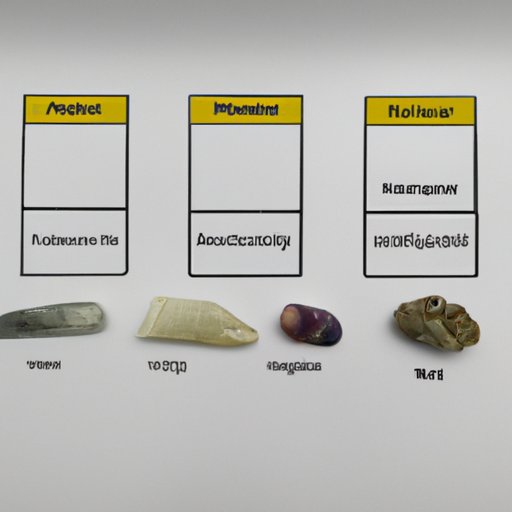Introduction
Mineral luster is a term used to describe the way a mineral reflects light. It’s an important physical property that helps geologists identify minerals and classify them into different groups. There are several types of mineral lusters, and each type has its own unique characteristics. In this article, we’ll explore what mineral luster is and how it can be used for mineral identification and geological research.

Exploring the Different Types of Mineral Lusters
There are three main types of mineral lusters: metallic, nonmetallic, and submetallic. Each type has its own unique characteristics that help geologists distinguish one mineral from another.
Metallic Luster
Metallic luster describes minerals that reflect light like a metal, such as silver or gold. These minerals typically have a shiny surface that appears reflective. Examples of minerals with metallic luster include pyrite (also known as “fool’s gold”) and galena.
Nonmetallic Luster
Nonmetallic luster describes minerals that do not reflect light like a metal. These minerals typically appear dull and may even be translucent or waxy. Examples of minerals with nonmetallic luster include quartz and calcite.
Submetallic Luster
Submetallic luster is a combination of metallic and nonmetallic luster. These minerals typically have a dull, slightly reflective surface. Examples of minerals with submetallic luster include hematite and magnetite.

An Overview of How to Identify Mineral Lusters
The most common way to identify mineral lusters is through visual examination. Geologists look at the surface of the mineral and observe how it reflects light. However, there are also other methods of testing, such as using a polarizing microscope or a reflectance spectrometer.
Examining Mineral Luster: A Guide for Beginners
When examining mineral luster, it’s important to look for certain characteristics. For example, metallic luster minerals typically have a shiny surface that reflects light, while nonmetallic luster minerals typically have a dull, non-reflective surface. Submetallic luster minerals have a dull, slightly reflective surface. It’s also important to pay attention to the color of the mineral, as this can provide clues about its luster.
It’s also important to avoid common mistakes when examining mineral luster. For example, some minerals may appear to have a metallic luster, but they may actually be a different type of luster. It’s important to look closely and make sure you’re accurately identifying the luster.

The Significance of Mineral Luster in Geology
Mineral luster is an important physical property that helps geologists identify minerals and classify them into different groups. According to Dr. Richard Harwood, Professor of Geology at the University of Colorado Denver, “Mineral luster is a key factor in mineral identification because it can provide clues about the composition and structure of the mineral.”
Mineral luster is also an important tool for geological research. Geologists use luster to determine the origin and history of a rock or mineral sample. For example, if a rock has a metallic luster, it could indicate that it formed in a hydrothermal environment. By examining the luster of a sample, geologists can gain valuable insight into the formation and composition of the sample.
What Is Mineral Luster? A Comprehensive Guide
Mineral luster is a term used to describe the way a mineral reflects light. It’s an important physical property that helps geologists identify minerals and classify them into different groups. There are three main types of mineral lusters: metallic, nonmetallic, and submetallic. Each type has its own unique characteristics that help geologists distinguish one mineral from another.
Identifying mineral luster requires careful observation and testing. Visual examination is the most common method, but there are also other methods such as using a polarizing microscope or a reflectance spectrometer. Geologists use luster to determine the origin and history of a rock or mineral sample, and it’s an important tool for mineral identification and geological research.
Conclusion
Mineral luster is an important physical property that helps geologists identify and classify minerals. There are three main types of mineral lusters: metallic, nonmetallic, and submetallic. Careful examination and testing are required to accurately identify mineral lusters. Mineral luster is also an important tool for geological research, as it can provide valuable insight into the formation and composition of a sample.
(Note: Is this article not meeting your expectations? Do you have knowledge or insights to share? Unlock new opportunities and expand your reach by joining our authors team. Click Registration to join us and share your expertise with our readers.)
